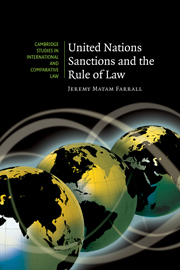Book contents
- Frontmatter
- Contents
- Extended Table of Contents
- Preface
- Abbreviations
- Part I Setting the scene
- Part II The evolution of the UN sanctions framework
- 3 From Aegina to Abyssinia: a prehistory of UN sanctions
- 4 Sanctions under the UN Charter
- Part III UN sanctions in practice
- Part IV Strengthening the rule of law
- Appendix 1 Summary of policy recommendations
- Appendix 2 Summaries of UN sanctions regimes
- Appendix 3 Tables
- Bibliography
- Index
- Cambridge Studies in International and Comparative Law
3 - From Aegina to Abyssinia: a prehistory of UN sanctions
Published online by Cambridge University Press: 26 June 2009
- Frontmatter
- Contents
- Extended Table of Contents
- Preface
- Abbreviations
- Part I Setting the scene
- Part II The evolution of the UN sanctions framework
- 3 From Aegina to Abyssinia: a prehistory of UN sanctions
- 4 Sanctions under the UN Charter
- Part III UN sanctions in practice
- Part IV Strengthening the rule of law
- Appendix 1 Summary of policy recommendations
- Appendix 2 Summaries of UN sanctions regimes
- Appendix 3 Tables
- Bibliography
- Index
- Cambridge Studies in International and Comparative Law
Summary
Although the UN Charter contained many innovations, the idea of sanctions was not one of them. Precedents existed for most of the forms of coercion short of the use of force envisaged by Article 41. Just a generation earlier, sanctions had also featured in the thinking of the founders of the League of Nations. Article 16, paragraph 1 of the Covenant of the League of Nations provided for the application of economic sanctions against a state which had illegally resorted to war. But the evolution of UN sanctions began well before even the League's experiment with sanctions. The notion underpinning UN sanctions – that coercive measures short of the use of force can be employed to compel the resolution of international disputes – has influenced decision-making in the arena of international relations for centuries.
Sanctions in ancient and medieval times
States and quasi-state entities have employed a variety of non-military coercive strategies as a means of pursuing foreign policy objectives since at least the days of ancient Greece. In 492 bc the Greek city-state of Aegina took non-military coercive action against Athens by seizing an Athenian ship and holding its passengers hostage. The action was taken in retaliation for the refusal of Athens to release ten Aeginetan citizens whom it was holding captive. Just over half a century later, in 432 bc, Athens itself took non-military coercive action by imposing a ban upon the importation of products from Megara.
- Type
- Chapter
- Information
- United Nations Sanctions and the Rule of Law , pp. 45 - 57Publisher: Cambridge University PressPrint publication year: 2007



